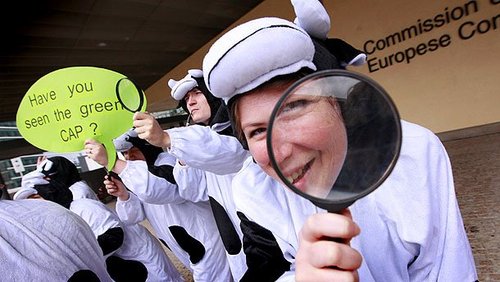The green apple of discord in the new Common Agricultural Policy
 A few months ahead of the supposed completion of discussions of the European Union’s new Common Agricultural Policy (CAP), there is still heated debate underway about it with few points of convergence of conflicting views. Apart from the cardinal issue of the 2014-2020 EU that is likely to shape up the agricultural policy itself, the trend of this policy getting increasingly greener has emerged as the apple of discord.
A few months ahead of the supposed completion of discussions of the European Union’s new Common Agricultural Policy (CAP), there is still heated debate underway about it with few points of convergence of conflicting views. Apart from the cardinal issue of the 2014-2020 EU that is likely to shape up the agricultural policy itself, the trend of this policy getting increasingly greener has emerged as the apple of discord.
This is indeed, a major challenge to resolve. In times of ever growing demand for food across the world and very dynamic prices in the sector, farmers need support more than ever. “The five decades of relative stability on the food market are now over and we have entered the era of shortages, argues Paolo di Castro, Chairman of the Committee on Agriculture in the European Parliament. He believes that food supply security will become a key problem in the new millennium. Against this backcloth, how can growing food production reconcile with greater care of the natural environment in farming regions so as to guarantee the development of sustainable agriculture in the long term?
The introduction of a requirement for 30 percent of green activities bound to direct payments and 25 percent under the rural development programmes represents an attempt to strike a difficult balance. Will this work? Many members of the European Parliament believe that environmental standards should be adjusted to the specific regions and countries that differ largely.
“The said 30 percent that bind direct payments to the criteria for nature protection represents a very high percentage”, argues the Bulgarian MEP Maria Gabriel, member of the Committee on Agriculture of the European Parliament. “Countries such as Germany however insist on an even higher nature-friendly percentage – up to 40-50 percent in green activities. Bulgaria and other EU countries too, believe that fixed percentages and criteria that are universal for all countries fail to match the specifics of regions and of agricultural development that varies greatly from country to country. Well, for the time being at least it is not very clear who will back the green component as it is now and who will oppose it.”
The most disputable point is the requirement for a seven percent of fallow land on farms. Seven percent fallow land implies seven percent less production and seven percent less income, MEP Maria Gabriel explains. Countries such as Denmark suggest that this requirement should be valid not for every single farm but rather to the whole territory of a certain region or country. This proposal is worth considering, given that in Bulgaria there is still plenty of uncultivated land that can easily make up for the seven percent in question.”
“The policy of green practices in agriculture is strongly disputed”, Portuguese Luis Manuel Capoulas admits. Capoulas is one of the rapporteurs for the Common Agriculture Policy at the Committee on Agriculture of the European Parliament. “One of the bones of contention is the requirement for leaving seven percent of the cultivated land as fallow land for the sake of preserving biodiversity. Some believe that this percentage is too high, others argue it is too low and still others oppose it altogether. In my report there is the following suggestion: when two farms are neighboring on each other then the fallow land should be left on the borderline strip of land between them and each will be required to abandon 5 percent as fallow land. This will provide for an even wider corridor for biodiversity. The Greens were very angry at me. However I hope that we will be able to find support for my proposal and it is dropping out green criteria in direct payments for farms with an area smaller than 20 ha.”
The latter proposal serves the interest of Bulgarian agriculture as land here is divided into mostly small plots of land. Bulgaria’s stance is that payments for 30 percent of nature-friendly activities should not be bound to direct payments. This means that if a farmer does not involve in green activities and is not entitled to financing for that, he would still have access to direct payments for agriculture. In this sense Bulgaria has got a bit of bitter experience from the current programming period for which 25 percent of the budget of the Rural Development Programme has been negotiated to go for environmental measures. For reasons that have to do with lack of experience in environmental farming of both farmers and the administration, the country might in the end lose close to 400m euros in European funding.
Text and photo: bnr.bg
(16.10.2012)